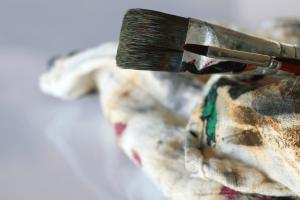Mastering the Art of Cleaning Oil-Based Paint: A Comprehensive Guide

-
Quick Links:
- Introduction
- Understanding Oil-Based Paint
- Safety Precautions
- Essential Tools and Materials
- Step-by-Step Guide
- Cleaning Different Surfaces
- Case Studies
- Expert Insights
- Conclusion
- FAQs
Introduction
Cleaning oil-based paint can be a daunting task, especially for those unfamiliar with the right techniques and materials. This guide aims to provide you with comprehensive insights, step-by-step instructions, and expert advice to make your paint cleaning journey as smooth as possible.
Understanding Oil-Based Paint
Oil-based paints are renowned for their durability and rich finish. However, their cleaning process requires specific techniques due to the nature of the paint's composition. Understanding the properties of oil-based paint is crucial for effective cleaning.
- Durability: Oil-based paints are resistant to moisture and wear.
- Drying Time: They take longer to dry compared to water-based paints.
- Cleaning Solvents: Oil-based paints require solvents like mineral spirits or turpentine for cleaning.
Safety Precautions
Before beginning your cleaning process, it's essential to consider safety. Here are the necessary precautions to take:
- Work in a well-ventilated area to avoid inhaling fumes.
- Wear gloves and protective eyewear to prevent skin and eye irritation.
- Keep flammable materials away from your workspace.
- Dispose of cleaning materials according to local regulations.
Essential Tools and Materials
Having the right tools and materials can make the cleaning process more effective. Here's what you'll need:
- Mineral spirits or turpentine
- Soft cloths or rags
- Paint scraper
- Protective gloves
- Bucket
- Water
- Sponge
- Soap
Step-by-Step Guide
Follow these steps to clean oil-based paint effectively:
Step 1: Prepare Your Workspace
Ensure your workspace is well-ventilated and free from clutter. Lay down drop cloths to protect surrounding areas.
Step 2: Apply Solvent
Soak a cloth in mineral spirits or turpentine and gently dab it onto the paint stain. Allow it to sit for a few minutes to loosen the paint.
Step 3: Scrape Off Paint
Using a paint scraper, gently remove the softened paint. Be careful not to damage the underlying surface.
Step 4: Clean the Area
After removing the paint, clean the area with soap and water to remove any residue from the solvent.
Step 5: Dry the Surface
Wipe the area with a dry cloth and let it air dry completely before applying any new paint or finishes.
Cleaning Different Surfaces
Wood Surfaces
For wooden surfaces, use a gentle touch to avoid scratching the wood. Follow the steps outlined above, and always test a small area first.
Metal Surfaces
Metal surfaces can be cleaned similarly, but ensure that the solvent does not cause rust. Rinse thoroughly with water after cleaning.
Fabric and Upholstery
For fabric, it's best to consult a professional cleaner, as solvents can damage fibers.
Case Studies
Let's explore some real-world examples of successful oil-based paint cleaning:
Case Study 1: The Living Room Makeover
A homeowner accidentally spilled oil-based paint on their hardwood floor during a DIY project. By following the steps outlined in this guide, they successfully removed the paint without damaging the floor.
Case Study 2: The Vintage Chair Restoration
Another case involved a vintage chair with oil-based paint stains on the fabric. After careful consideration, the owner decided to use a professional cleaning service to avoid damaging the upholstery.
Expert Insights
We consulted with professional painters and cleaning experts to gather their insights on best practices:
"Always test solvents on a hidden area first. This helps you avoid any unwanted damage to the surface." - John Doe, Professional Painter
"For large projects, consider using a paint stripper as an alternative to solvents, especially for intricate surfaces." - Jane Smith, Cleaning Specialist
Conclusion
Cleaning oil-based paint doesn't have to be an overwhelming task. By understanding the properties of the paint, taking necessary safety precautions, and following a structured cleaning process, you can restore surfaces to their original condition.
FAQs
1. What is the best solvent for cleaning oil-based paint?
The best solvents for cleaning oil-based paint are mineral spirits and turpentine.
2. Can I use water to clean oil-based paint?
Water is not effective for cleaning oil-based paint. Solvents are required to break down the paint.
3. Is it safe to use solvents indoors?
Always ensure good ventilation when using solvents indoors to avoid inhaling fumes.
4. How do I know if the paint is oil-based?
To check, apply a small amount of rubbing alcohol to a cotton ball and rub it on the paint. If it smears, it's likely oil-based.
5. Can I remove oil-based paint from fabric?
It's recommended to consult a professional for fabric cleaning, as solvents can damage fibers.
6. How can I safely dispose of used solvents?
Check with local regulations for hazardous waste disposal sites to safely dispose of used solvents.
7. What if the paint won’t come off?
Consider using a commercial paint stripper or consult a professional cleaning service for challenging stains.
8. Are there eco-friendly options for cleaning oil-based paint?
Yes, there are eco-friendly paint strippers available that are less harmful to the environment.
9. Can I use vinegar to clean oil-based paint?
Vinegar is not effective for cleaning oil-based paint; solvents are necessary for proper removal.
10. How do I prevent paint spills in the future?
Using drop cloths and painter's tape can help prevent spills and protect surfaces while painting.